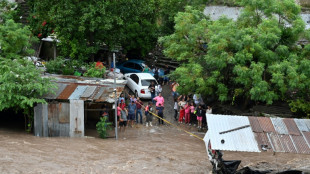
-
 Spain royals to visit flood epicentre after chaotic trip: media
Spain royals to visit flood epicentre after chaotic trip: media
-
French farmers step up protests against EU-Mercosur deal

-
 Burst dike leaves Filipino farmers under water
Burst dike leaves Filipino farmers under water
-
Markets rally after US bounce as Nvidia comes into focus

-
 Crisis-hit Thyssenkrupp books another hefty annual loss
Crisis-hit Thyssenkrupp books another hefty annual loss
-
Farmers descend on London to overturn inheritance tax change

-
 Floods strike thousands of houses in northern Philippines
Floods strike thousands of houses in northern Philippines
-
SpaceX set for Starship's next flight, Trump expected to attend

-
 Several children injured in car crash at central China school
Several children injured in car crash at central China school
-
Urban mosquito sparks malaria surge in East Africa

-
 Many children injured after car crashes at central China school: state media
Many children injured after car crashes at central China school: state media
-
Asian markets rally after US bounce as Nvidia comes into focus

-
 Tens of thousands march in New Zealand Maori rights protest
Tens of thousands march in New Zealand Maori rights protest
-
Five takeaways from the G20 summit in Rio

-
 Parts of Great Barrier Reef suffer highest coral mortality on record
Parts of Great Barrier Reef suffer highest coral mortality on record
-
Defiant Lebanese harvest olives in the shadow of war

-
 Divided G20 fails to agree on climate, Ukraine
Divided G20 fails to agree on climate, Ukraine
-
Can the Trump-Musk 'bromance' last?

-
 US to call for Google to sell Chrome browser: report
US to call for Google to sell Chrome browser: report
-
Trump expected to attend next Starship rocket launch: reports

-
 Stocks, dollar hesitant as traders brace for Nvidia earnings
Stocks, dollar hesitant as traders brace for Nvidia earnings
-
Biden in 'historic' pledge for poor nations ahead of Trump return

-
 Tropical storm Sara kills four in Honduras and Nicaragua
Tropical storm Sara kills four in Honduras and Nicaragua
-
Spanish resort to ban new holiday flats in 43 neighbourhoods

-
 Phone documentary details Afghan women's struggle under Taliban govt
Phone documentary details Afghan women's struggle under Taliban govt
-
G20 wrestles with wars, 'turbulence' in run-up to Trump

-
 Stocks, dollar hesitant as traders eye US rate outlook, Nvidia
Stocks, dollar hesitant as traders eye US rate outlook, Nvidia
-
G20 wrestles with wars, climate in run-up to Trump

-
 G20 host Brazil launches alliance to end 'scourge' of hunger
G20 host Brazil launches alliance to end 'scourge' of hunger
-
Stocks, dollar hesitant as traders scale back US rate cut bets

-
 Trump confirms plan to use military for mass deportation
Trump confirms plan to use military for mass deportation
-
UN climate chief at deadlocked COP29: 'Cut the theatrics'

-
 Tractor-driving French farmers protest EU-Mercosur deal
Tractor-driving French farmers protest EU-Mercosur deal
-
Floods hit northern Philippines after typhoon forces dam release

-
 Markets mixed after Wall St losses as traders weigh US rates outlook
Markets mixed after Wall St losses as traders weigh US rates outlook
-
Law and disorder as Thai police station comes under monkey attack

-
 Philippines cleans up as typhoon death toll rises
Philippines cleans up as typhoon death toll rises
-
Long delayed Ukrainian survival video game sequel set for release amid war

-
 Philippines cleans up after sixth major storm in weeks
Philippines cleans up after sixth major storm in weeks
-
Markets swing after Wall St losses as traders weigh US rates outlook

-
 Gabon early results show voters back new constitution
Gabon early results show voters back new constitution
-
Is AI's meteoric rise beginning to slow?

-
 Biden touts climate legacy in landmark Amazon visit
Biden touts climate legacy in landmark Amazon visit
-
Biden clears Ukraine for long-range missile strikes inside Russia

-
 'Nobody can reverse' US progress on clean energy: Biden
'Nobody can reverse' US progress on clean energy: Biden
-
Biden allows Ukraine to strike Russia with long-range missiles: US official

-
 Biden clears Ukraine for missile strikes inside Russia
Biden clears Ukraine for missile strikes inside Russia
-
Ukrainians brave arduous journeys to Russian-occupied homeland

-
 'Devil is in the details,' EU chief says of S.America trade deal
'Devil is in the details,' EU chief says of S.America trade deal
-
Toll in Tanzania building collapse rises to 13, survivors trapped


Cleanup hopes for neighbors of Mexico's 'toilet bowl' wastewater dam
On the banks of a wastewater dam in central Mexico, under a dense cloud of mosquitoes, Yury Uribe is finally seeing hope after spending decades in "environmental hell."
The 43-year-old lives next to the Endho dam, sometimes described as Mexico's "toilet bowl" for receiving the wastewater of around 22 million people in the capital as well as runoff from a thermoelectric plant, a refinery and other industries that surround it.
Even corpses have been found in its reservoir's murky waters.
Twenty years ago, Uribe and fellow residents of the town of Tepetitlan launched a campaign to rehabilitate the dam, whose waters contaminate drinking wells and are blamed by the community for cancer and other diseases.
Now, their efforts are just weeks from starting to bear fruit, with the government on the verge of passing a decree to restore Endho and the surrounding reservoir.
"We hope the day will come that the soil recovers and not everything we touch will be dead," Uribe, a dressmaker in the town, told AFP.
She is a co-founder of the Social Movement for the Earth, established in 2004 to highlight the disaster affecting an area covering almost 25,000 hectares (some 61,780 acres) and described by the government in 2019 as an "environmental hell."
These are areas "sacrificed so that Mexico City can function well," its wastewater and rainfall overflow discharged here -- some 70 miles (110 kilometers) away -- so as not to flood, said Uribe.
- 'There is no life' -
The community's struggle has been a long one.
After repeatedly occupying the offices of the environment ministry and the National Water Commission (Conagua) in recent years, they got the government to conduct an environmental study in June.
Now, the government is preparing to issue a decree next month to "restore" the dam by reducing wastewater discharge and improving water treatment.
It will likely be the first step in a long process.
The dam's reservoir is surrounded by trees and fields that are sometimes reflected in its surface, projecting an idyllic image although in those waters "there is no life," one resident commented.
When AFP visited, a human corpse floated among the lilies and garbage -- the third to appear in a month, according to locals.
The stink is the least of the problems. In Tepetitlan, the conversation invariably revolves around cancer.
For the inhabitants, there is no doubt the pollution is the cause.
"This is because of what we eat, what we breathe, the environment," said Irma Gonzalez, a 47-year-old breast cancer patient.
"Many of us already have cancer," added her neighbor Blanca Santos, 64, whose lungs are affected.
Conagua studies show that water from wells near the dam is not suitable for consumption due to high levels of heavy metals such as arsenic and mercury.
These pollutants come from industries that discharge their water into the Tula River and other tributaries that flow into the reservoir.
- 'Chromosomal alterations' -
Authorities have promised to investigate a possible relationship between pollution and disease.
Oncologist Eduardo Amieva told AFP that heavy metals can "start to accumulate in organs" such as the kidney, liver, skin or bladder.
This, in turn, can lead to "chromosomal alterations and eventually cancer," he said.
Farms in the Mezquital Valley have long used water from the dam to irrigate their crops.
Products from there, such as corn, chili, beans or alfalfa are sold in Mexico City and other states of the country.
"This water has brought us benefits" but also "harm," said Victor Angeles, a corn farmer whose family includes several cancer patients.
Government regulations state that tall crops such as maize can be irrigated with wastewater, but not those in direct contact with the land, said Edith Garcia, a water management specialist.
Y.Ponomarenko--CPN
